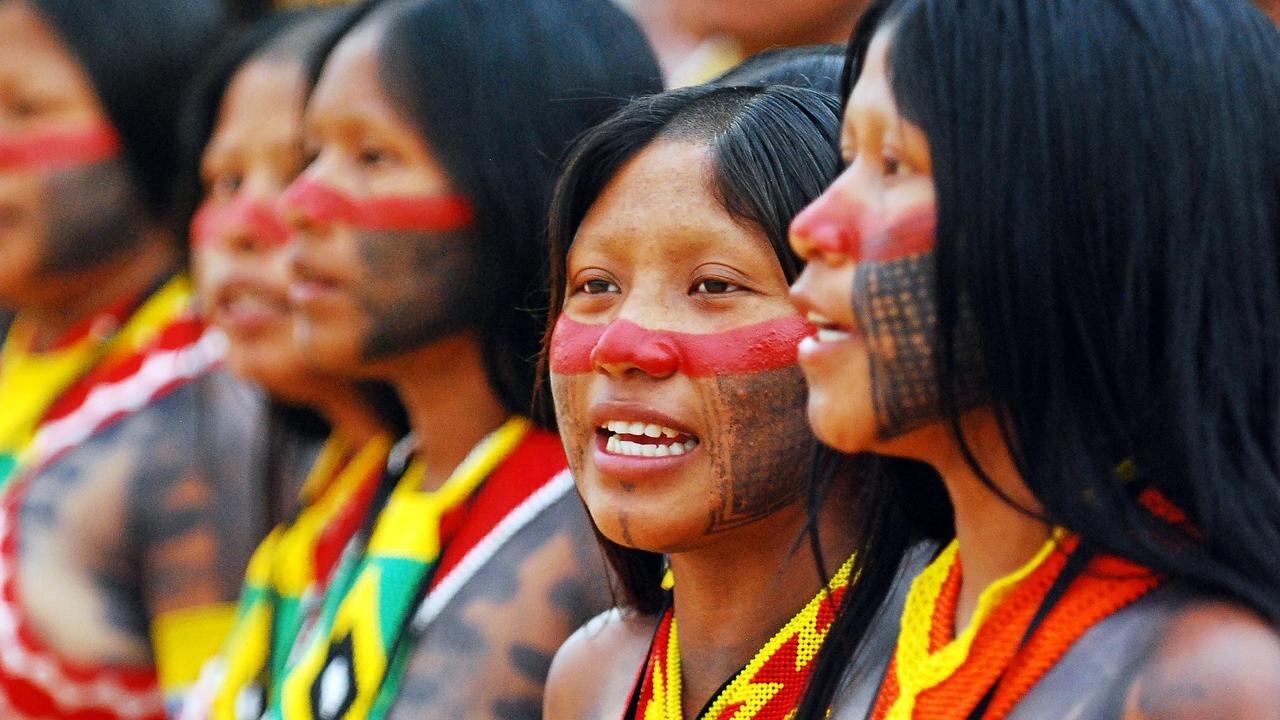Premium Only Content

Kayapo Dance | Cultural dance African - AROUNDTHEWORLDWITHUS
The Kayapo (Portuguese: Caiapó [kajaˈpɔ]) people are the indigenous people in Brazil who inhabit a vast area spreading across the states of Pará and Mato Grosso, south of the Amazon River and along Xingu River and its tributaries. This pattern has given rise to the nickname the Xingu tribe. They are one of the various subgroups of the great Mebêngôkre nation (people from the water’s source).The term "Kayapo" is used by neighbouring groups rather than the Kayapo themselves. They refer to outsiders as "Poanjos".
The type of sweet potato that forms an important part of the Kayapó diet is sometimes named "caiapo", after the tribe. It is cultivated under that name in Japan, and has been found to have health benefits.
Location
See also: Kayapó Indigenous Territory
The Kayapo tribe lives alongside the Xingu River in the most east part of the Amazon Rainforest, in the Amazon basin, in several scattered villages ranging in population from one hundred to one thousand people in Brazil. Their land consists of tropical rainforest savannah (grassland) and is arguably the largest tropical protected area in the entire world, covering 11,346,326 hectares of Neotropical forests and scrubland containing many endangered species.They have small hills scattered around their land and the area is criss-crossed by river valleys. The larger rivers feed into numerous pools and creeks, most of which don’t have official names.
In 2018, there was an estimated 8,638 Kayapo people, which is an increase from 7,096 in 2003. Subgroups of the Kayapo include the Xikrin, Gorotire, Mekranoti and Metyktire. Their villages typically consist of a dozen huts. A centrally located hut serves as a meeting place for village men to discuss community issues.
Name
The term Kayapo, also spelled Caiapó or Kaiapó, came from neighboring peoples in the early 19th century and means "those who look like monkeys". This name is probably based on a Kayapó men's ritual involving monkey masks. The autonym for one village is Mebêngôkre, which means "the men from the water hole." Other names for them include Gorotire, Kararaô, Kuben-Kran-Krên, Kôkraimôrô, Mekrãgnoti, Metyktire, and Xikrin.
Appearance
Kayapo women, Pará State, Brazil
The Kayapo use intricate black body paint covering their entire bodies. They believe that their ancestors learned their social skills from insects, so they paint their bodies to mimic them and to better communicate with the Spirit that exists everywhere. The black body paint also allows them to blend into their surroundings when hunting in the forests. To help find their way through the forest, the Kayapo paint their legs with red pigment that rubs off on the surrounding terrain. The colors that a Kayapo wears is representative of their tribe's colors.
Older generations of Kayapo men wear disks in their lower lips, but the practice is less common among younger Kayapo men. The men adorn themselves with radiating feathers, representing the universe, in their hair. Kayapo men also can be seen with rope in their hair, to represent the rope which the first Kayapo used to arrive from the sky. Traditionally, Kayapo men cover their lower bodies with sheaths.[clarification needed] Due to increased contact with outside cultures, contemporary Kayapo often wear Western-style clothing such as shorts. Kayapo chiefs wear a headdress made out of bright yellow feathers to represent the rays of the sun. The feathers used in their headdresses are from birds native to their area such as hyacinth macaw and crested oropendola. The birds found in the Amazon are naturally bright-colored; the Kayapo do not dye the feathers. Kayapo children wear cloth or beaded bands with colors representing their tribes. Typically these bands are tied below the waist or crisscrossed around the torso. When the child become of age, they go through a naming ceremony in which they wear large yellow headdresses.
Kayapo women can be distinguished by the V shape shaved into their hair.
Language
They speak the Kayapo language, which belongs to the Jê language family. The Kayapo are split into many groups, resulting in different dialects of their language. The Kayapo value oratory highly, calling themselves those who speak beautifully (Kaben mei) when compared to other indigenous groups. Beauty is valued highly in the Kayapo culture. A beautiful name is seen as a sign of wealth. The tribe will move and re-construct their camp in order to find the materials required to undertake the naming ceremony eg. Sufficient food sources for celebration must be gathered and presented to the father of the new-born. During certain occasions, Kayapo men may speak as if someone is punching them in the stomach. The Kayapo possess varying knowledge of Portuguese, depending on the individual groups and their history of contact with outsiders.
-
 3:05:49
3:05:49
TimcastIRL
7 hours agoNew DOCS PROVE Obama Hillary CONSPIRACY To SABOTAGE Trump Admin | Timcast IRL
211K86 -
 2:29:36
2:29:36
Laura Loomer
7 hours agoEP136: YOU'RE FIRED! White House Vetting Crisis Continues
52.4K24 -
 8:07
8:07
MattMorseTV
7 hours ago $5.51 earnedTrump just LOWERED PRICES by 75 PERCENT.
31.4K32 -
 LIVE
LIVE
Misfit Electronic Gaming
10 hours ago $3.68 earned"LIVE" "Blind Descent' +"Dollhouse of Dead" Playtest 10 Followers till we hit 1000! We CAN do this!
509 watching -
 21:53
21:53
Glenn Greenwald
9 hours agoMichael Tracey on the Street: What Do People Think of the Epstein Case?
124K57 -
 2:26:28
2:26:28
megimu32
6 hours agoOTS: Board Games Gone Wild! The Loud, Weird & Chaotic Games That Raised Us
33.7K9 -
 4:25:16
4:25:16
DamnDanieI
6 hours agoKill First, Loot Later – OTG Live
51.9K1 -
 56:41
56:41
Donald Trump Jr.
11 hours agoLies, Leaks, and Lawfare: Censorship Corruption Exposed | TRIGGERED Ep.263
174K145 -
 1:19:46
1:19:46
Precision Rifle Network
8 hours agoS4E25 Guns & Grub - Rex Is Back, I shot the 6.5PRC finally...
30.4K1 -

rhywyn
5 hours agoうつ
18.5K4